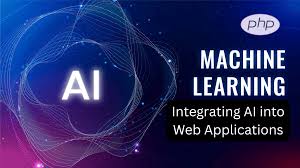PHP and AI: Integrating Machine Learning into Your Web Projects
In the rapidly evolving landscape of web development, integrating machine learning (ML) capabilities into web projects is becoming increasingly important. Machine learning can enhance user experiences, provide personalized recommendations, and improve decision-making processes. Traditionally, languages like Python and R have dominated the AI and ML space, but PHP developers can also leverage these technologies. In this blog, we'll explore how to integrate machine learning into your PHP web projects, providing your applications with a powerful new dimension.

Why Integrate Machine Learning with PHP?
- Enhanced User Experience: Machine learning algorithms can analyze user behavior and preferences to offer personalized content and recommendations.
- Improved Decision Making: AI can process vast amounts of data to provide insights and predictions, aiding better decision-making.
- Automation: Automate repetitive tasks such as data entry, customer support, and more, freeing up time for more complex tasks.
- Competitive Edge: Staying ahead of the competition by implementing advanced technologies in your web applications.
Approaches to Integrating Machine Learning with PHP
1. Using Machine Learning APIs
One of the easiest ways to incorporate machine learning into your PHP projects is by using third-party APIs. These APIs handle the heavy lifting of model training and prediction, allowing you to focus on integrating the results into your application.
Example: Using Google Cloud AI
Google Cloud offers a variety of machine learning APIs that you can integrate with PHP, such as the Vision API, Natural Language API, and more.
Step 1: Set Up Google Cloud API
- Create a Google Cloud account and set up a new project.
- Enable the necessary APIs (e.g., Vision API, Natural Language API).
- Generate an API key or service account credentials.
Step 2: Install Google Cloud PHP Client Library
Use Composer to install the Google Cloud PHP client library:
composer require google/cloud
Step 3: Integrate the API in Your PHP Project
Here's an example of using the Vision API to analyze an image:
require 'vendor/autoload.php'; use Google\Cloud\Vision\V1\ImageAnnotatorClient; function analyzeImage($imagePath) { $imageAnnotator = new ImageAnnotatorClient([ 'credentials' => 'path/to/your-service-account-file.json' ]); $image = file_get_contents($imagePath); $response = $imageAnnotator->labelDetection($image); $labels = $response->getLabelAnnotations(); echo "Labels for the image:\n"; foreach ($labels as $label) { echo $label->getDescription() . "\n"; } $imageAnnotator->close(); } analyzeImage('path/to/your-image.jpg');
2. Using PHP Libraries with Python Integration
While PHP does not have native libraries for machine learning, you can bridge the gap by integrating Python scripts that handle the ML part and communicate with your PHP application.
Example: Using Python with PHP
Step 1: Create a Python Script
Let's say we have a Python script (predict.py) that uses a pre-trained machine learning model:
# predict.py import sys import json import numpy as np from sklearn.externals import joblib # Load the model model = joblib.load('model.pkl') # Read input data input_data = json.loads(sys.argv[1]) data = np.array(input_data) # Make prediction prediction = model.predict(data) # Output prediction print(json.dumps(prediction.tolist()))
Step 2: Call the Python Script from PHP
Use PHP's exec function to call the Python script and pass the data:
function getPrediction($inputData) { $inputJson = json_encode($inputData); $command = escapeshellcmd("python3 predict.py '$inputJson'"); $output = shell_exec($command); return json_decode($output, true); } $inputData = [[5.1, 3.5, 1.4, 0.2]]; // Example input data $prediction = getPrediction($inputData); echo "Prediction: " . print_r($prediction, true);
3. Using PHP Machine Learning Libraries
There are a few PHP libraries available that provide machine learning capabilities, such as PHP-ML.
Example: Using PHP-ML Library
Step 1: Install PHP-ML Library
Install the PHP-ML library using Composer:
composer require php-ai/php-ml
Step 2: Use PHP-ML in Your Project
Here's an example of training and predicting with a simple dataset using the PHP-ML library:
require 'vendor/autoload.php'; use Phpml\Classification\KNearestNeighbors; use Phpml\ModelManager; function trainModel() { $samples = [[1, 2], [3, 4], [5, 6], [7, 8]]; $labels = ['a', 'a', 'b', 'b']; $classifier = new KNearestNeighbors(); $classifier->train($samples, $labels); // Save the trained model $modelManager = new ModelManager(); $modelManager->saveToFile($classifier, 'model.knn'); } function predict($inputData) { $modelManager = new ModelManager(); $classifier = $modelManager->restoreFromFile('model.knn'); return $classifier->predict($inputData); } trainModel(); $inputData = [2, 3]; $prediction = predict($inputData); echo "Prediction: " . $prediction;
Conclusion
Integrating machine learning into your PHP web projects opens up a world of possibilities, from enhancing user experience to automating complex tasks. Whether you choose to leverage third-party APIs, integrate with Python scripts, or use PHP machine learning libraries, PHP provides the flexibility to incorporate AI and ML seamlessly into your applications. Start experimenting with these techniques today and transform your web projects with the power of machine learning.




